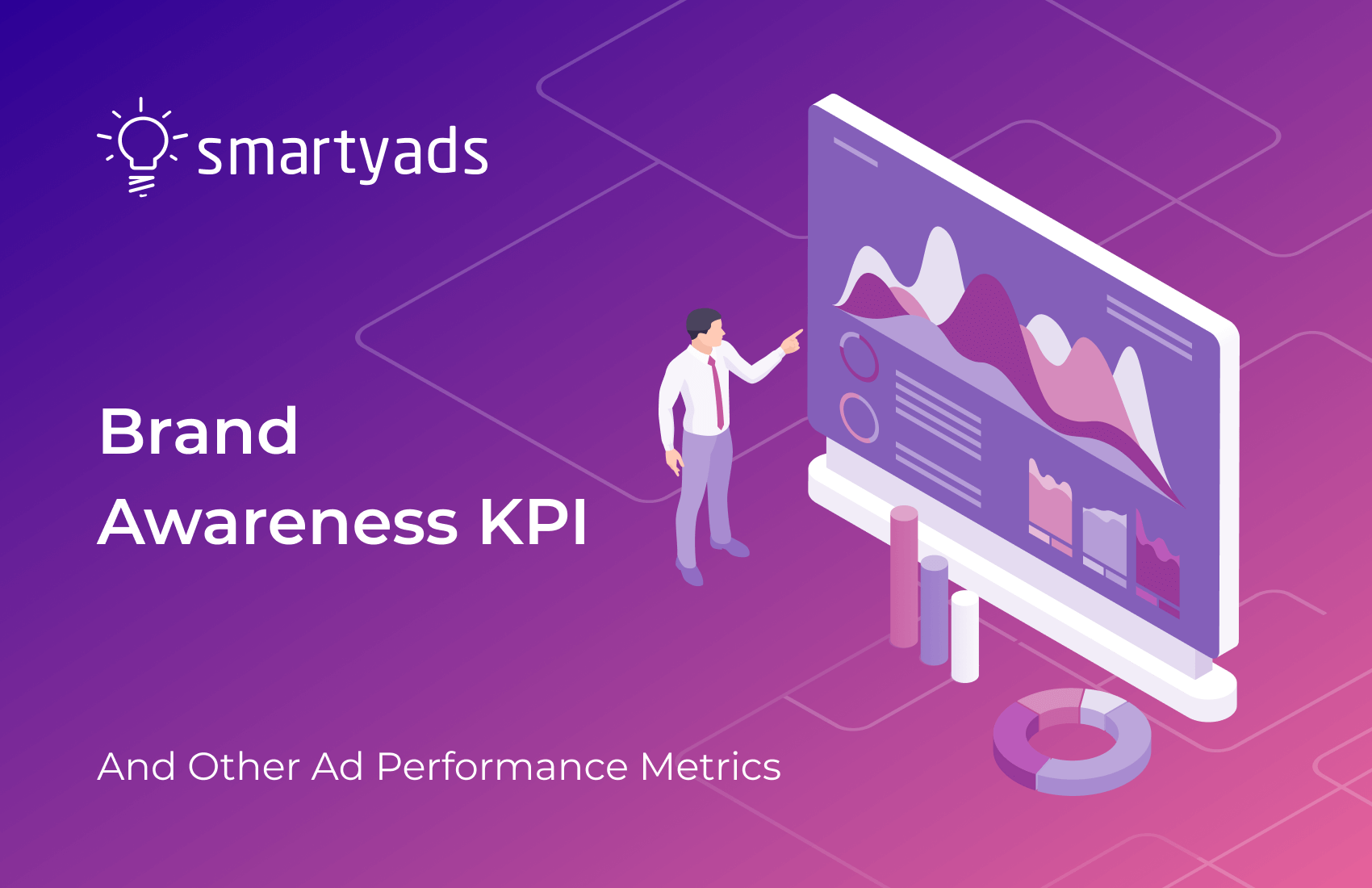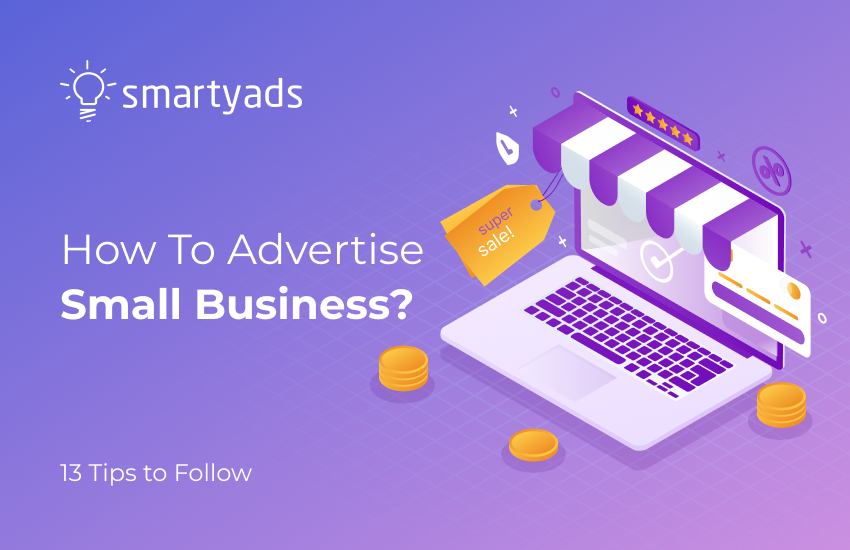Brand awareness KPIs should be on every marketer's agenda in 2023. Why? Brand awareness is the number one objective for 89% of companies; however, only 48% of those measure metrics related to branding. Brand awareness is a top-of-the-mind concern because most consumers will buy from one of the top three brands that appear in their consideration set at the moment of purchase. However, how exactly do you define brand awareness, how do you measure brand awareness, and what other metrics should you consider afterward?
As known, there are many ways to introduce consumers to your brand using advertising platforms like the DSP platform. Basically, DSP is a machine intended to run and measure brand awareness campaigns.
The main advantage is that programmatic advertising features global reach, meaning that broad geo coverage and targeting accuracy will contribute to great brand awareness. Apart from this, the analytics of the demand-side platform can provide you with a robust KPI dashboard. Using statistics that DSP accumulates, you can pinpoint the most important KPI for an advertising campaign.
KPI advertising: What brand awareness metrics matter?
Choosing the right brand awareness metrics is crucial as they enable measurement, evaluation, goal setting, and strategy alignment. These metrics help measure brand awareness, calculate the ROI of awareness campaigns, monitor performance, make informed decisions, benchmark against competitors, and provide accountability.
By measuring brand awareness, businesses can track progress, optimize strategies, allocate resources efficiently, and demonstrate the impact of their brand awareness initiatives, leading to improved brand performance and market positioning.
What is KPI in advertising in general? Those are essential brand awareness metrics that provide insights regarding how the ad campaign is performing. The typical DSP advertising platform has in-built analytics that generates reports across numerous real-time metrics. These include but are not limited to Impressions, Clicks, and CTR. However, the key brand awareness KPI indicator is the number of impressions.
While increasing brand awareness on DSP, you might want to hit additional goals like achieving higher conversions and sales. Thus, before starting an ad campaign on DSP, we recommend studying your targeted audience in order to work better with your objectives. As soon as you discover who your audience is, it's time to decide how they should interact with your brand.
Example. You are a startup or a new brand that is launching a product or service for the first time. You need recognition and awareness. Still, you will be interacting with people for the first time. To address new users, you need to measure KPI advertising metrics that belong to the top of the conversion funnel.
If your primary goal is affinity, you might also focus on interaction with creatives, such as measuring video completion (if you apply video ad formats). After this, you can measure secondary KPI for an advertising campaign, e.g., time spent on the website. You can also define the audience segments that actually complete the video to remind them about your product or service in a retargeting campaign, and so on.
KPI for brand awareness advertising campaign measurement:
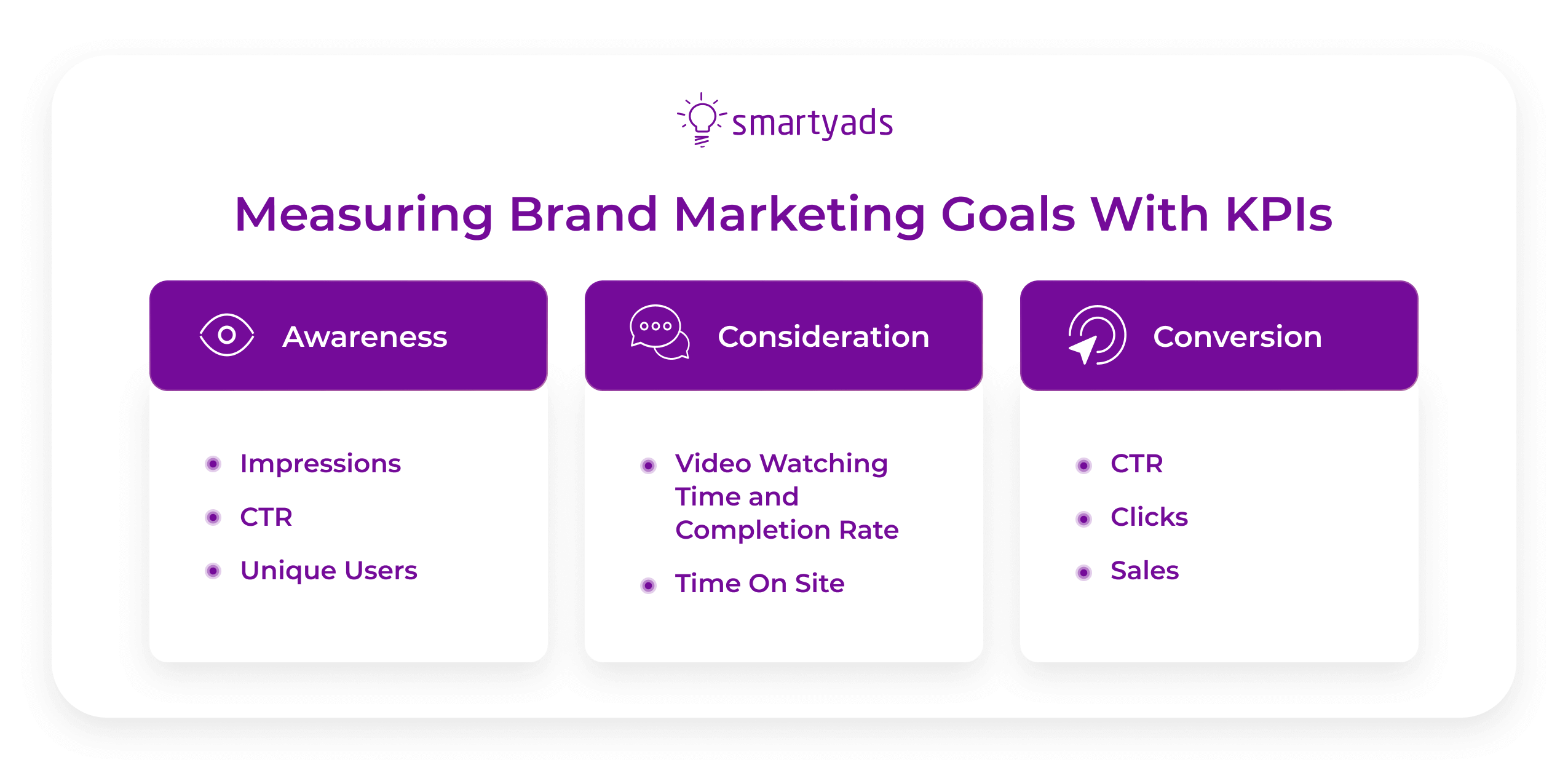
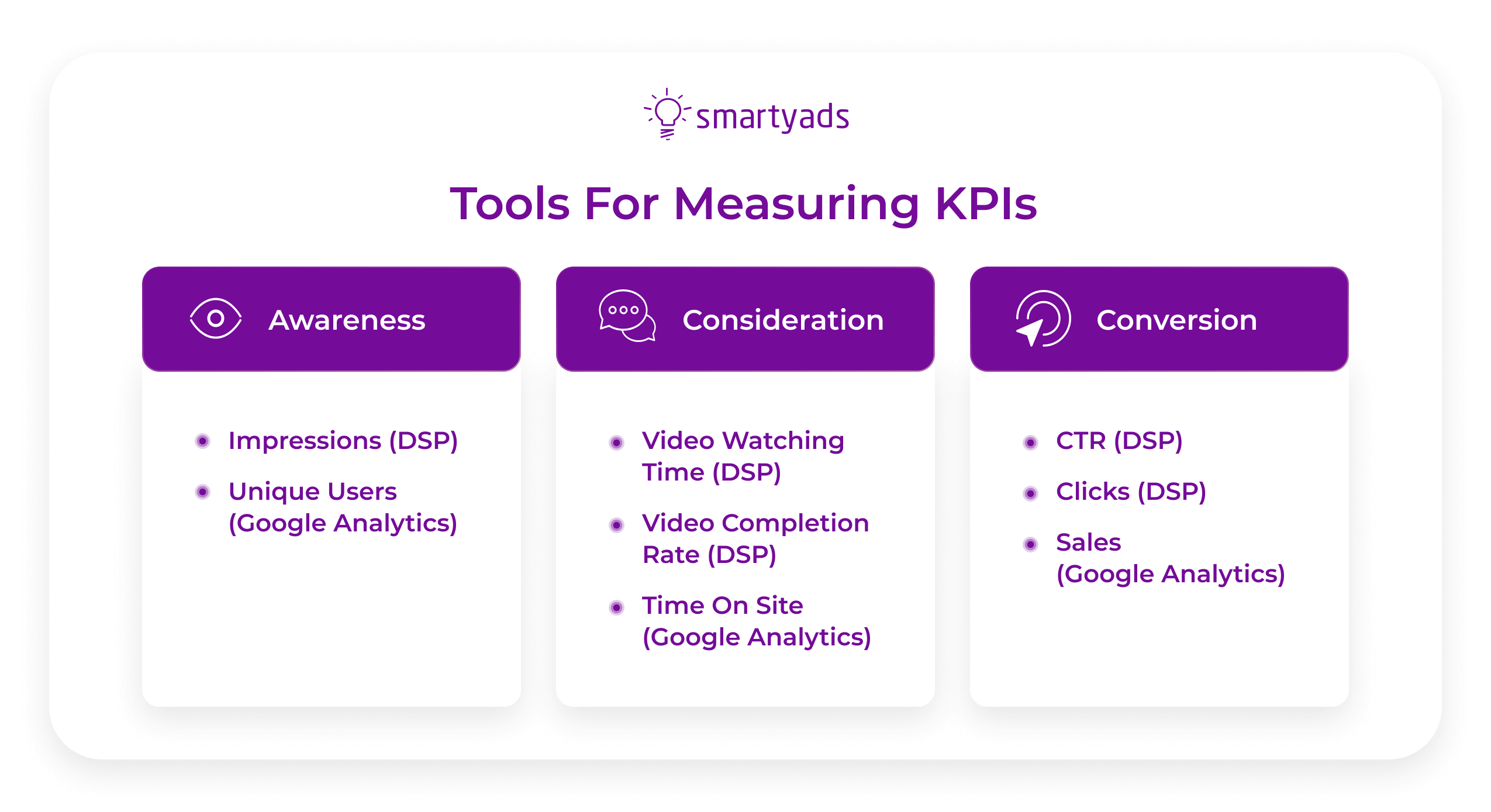
Brand Awareness Metrics
Impressions. Planning to launch awareness campaigns? That means your campaign success will primarily depend on how many people will see your ad. Thus, if you need to measure brand awareness, your core metric is the number of impressions. On SmartyAds DSP, all brand awareness metrics are distributed by days and hours. Go to the "report" section and find out how your campaign is performing.
Your perfect goal there is to serve the ads to as many targeted users as possible. Note that on DSP, impressions are targeted, which means they reach only those users whose cookie data corresponds to the targeting criteria you select (age, geo, language, etc.). It increases the likelihood of conversion and prevents serving ads to people outside the brand's targeted audience.
Unique users. In order to measure the number of unique users on your website, you will have to employ Google Analytics. If you have a Google Analytics account, you can access stats regarding unique visitors by following the path: Audience, Overview.
You will see the overall number of unique users during the period (should be selected) and the number of users who visited your site for the first time. You can also tie your Google Adwords and Facebook ad campaigns to GA to know how many new users each ad campaign brings.
CTR is a click-through rate; it shows the impressions-to-clicks ratio. It can be calculated according to the following formula: clicks/impressions. On programmatic ad platforms like SmartyAds, you can automatically obtain the CTR rate in the analytics. High CTR will mean that users actively engage with your campaigns and find them relevant.
Pro tip: The more impressions your campaign will generate, the more unique visitors you will receive on your website, so the better your brand awareness KPI metrics will be. At the brand awareness stage, we recommend using awareness-focused advertising formats like display ads, in-stream videos, and Connected TV.
Consideration of brand awareness campaign KPIs
Video watching time and completion rate. These metrics are attributed to the consideration of brand campaign KPIs because they provide insights regarding how your users react to your ads. If they actively interact with those or watch the videos to the end (100% completion), this might indicate that users are engaged and have a high purchase intent.
To lift your brand awareness metrics and KPIs to the consideration stage, tracking how users interact with your creatives is important. For this, advertisers can apply third-party tracking pixels on DSP platforms like SmartyAds.
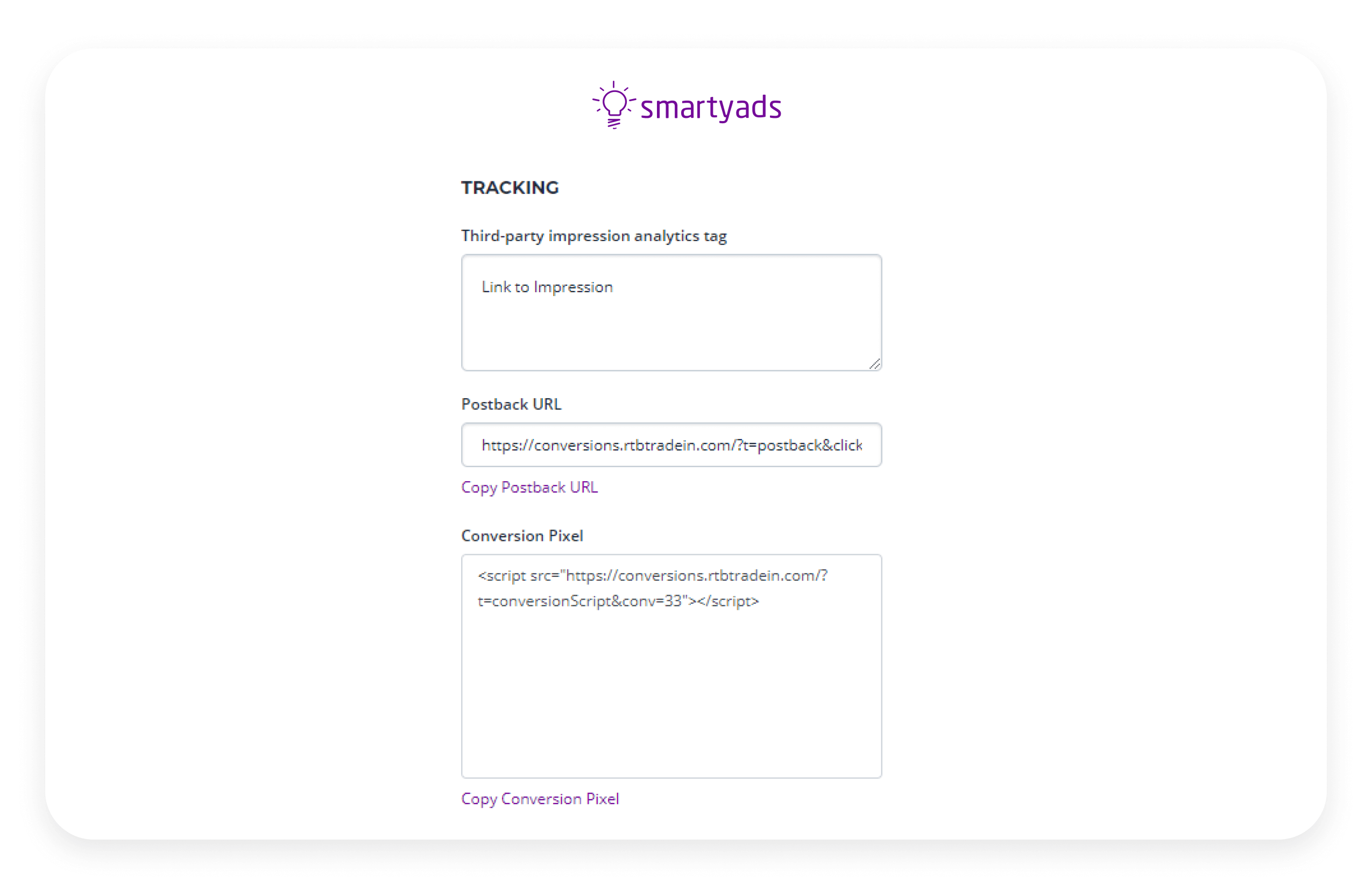
Time on site. When your customers are already familiar with your product or service, the average time spent on the landing page should increase. At this stage, customers review your offer in detail, compare it with alternatives, and prepare to make a final decision. With Google Analytics, you can track the dynamics.
Go to the Behavior, Overview to see the average time on the page and bounce rate. According to stats, two minutes is the average time people spend on site. In the same way, you can track time on the page for every taken website page. If the time on the page is too short, it means you need to improve the content and its readability.
Pro tip: Use high KPI display ads, native ad formats, and engaging interactive videos like rewarded and playable in-game formats. They will help you capture the users' attention at the consideration stage. Interactive formats like these provide the greatest options in terms of behavioral tracking mechanisms.
Programmatic advertising KPIs for conversion
Clicks. The DSP brand awareness campaign can also be measured in the total number of clicks. Such brand awareness KPIs like the number of clicks let you see how many clicks were generated out of the total number of served impressions during the period. For CPM advertising campaigns, this metric shows how many clicks an advertiser managed to generate out of 1000 served impressions. Same way as CTR, it is automatically calculated on a programmatic DSP.
Sales. It is an easy-to-use KPI to measure brand awareness on programmatic platforms. If you need to measure such key performance indicators as the number of sales, go to Google Analytics. For this, you can configure a sales performance report. After this, you will be able to see the total generated revenue, changes in conversion rate, and average order value during the period.
Branded search volume. Branded search volume refers to the number of searches conducted by users, specifically using a brand's name or variations of it as the search query. It represents users' level of interest and intent to find information, products, or services related to a particular brand. Branded search volume is a metric that helps measure a brand's popularity, recognition, and relevance in the online space. Higher volume indicates a strong brand presence and customer loyalty, as users actively seek out information or engage with the brand directly.
Pro tip: If your previous efforts on raising brand awareness and engagement didn't go in vain, your target audience would most likely complete the purchase. At this stage, your campaign optimization should encourage this final action; we highly recommend applying native creatives and launching retargeting campaigns at different mediums.
Key brand awareness KPI advertising metrics and tactics
| Goal | Key performance indicator (KPI) | Tactics |
Awareness/Site traffic
Getting better recall and recognition, finding new users |
CTR (↑) Impressions (↑) Unique users (↑) | Display ads In-stream videos Connected TV |
Consideration
Positioning the brand as a thought leader and expert | Video watching and completion (↑) Time on site (↑) |
Display ads Native ads Rewarded video Playable ads |
Conversion Elevating sales and conversions | Clicks(↑) Sales(↑) | Native ads Retargeting |
Increase product KPIs and brand awareness with the help of social media platforms
Social media can help you build brand awareness and increase brand KPIs. It is a very flexible and important tool in any marketer's arsenal. Let's take a look at how you can use media to achieve your goals.
Define clear objectives
Start by defining specific objectives for your social media efforts. These could include increasing website traffic, boosting sales, growing social media followers, or improving brand recognition. Clear objectives will help you focus your brand awareness strategies and measure success accurately.
Develop a consistent brand presence
Establish a consistent brand presence across your social media. Use consistent branding elements such as logos, color schemes, and brand voice. This builds recognition and reinforces your brand identity.
Create engaging and shareable content
Produce high-quality, engaging content that aligns with your brand and resonates with your target audience. Use a mix of content formats like images, videos, infographics, and interactive posts. Encourage social sharing by creating content that provides value, entertainment, or solves problems.
Utilize influencer marketing
Collaborate with influencers or industry experts with a significant following base and influence in your target market. They can promote your products or services to their audience, increasing brand visibility and credibility. Choose influencers whose values and audience align with your brand for better results.
Leverage user-generated content (UGC)
Encourage your audience to create and share content related to your products or brand. UGC not only increases engagement but also acts as social proof, building trust, and authenticity. Run UGC campaigns, contests, or hashtags to incentivize users to create and share content.
Engage with your audience
Social media is a two-way communication channel. Respond to comments, messages, and brand mentions promptly. Engage in conversations, answer questions, and address customer concerns. Actively participating in discussions builds a positive brand image and fosters customer loyalty.
Use targeted advertising
Social media offer powerful targeting options to reach specific audiences. Utilize these features to create targeted ad campaigns based on demographics, interests, behaviors, and previous interactions. This helps you reach people who are more likely to be interested in your products and increases the effectiveness of your advertising spend.
Collaborate with industry partners
Seek opportunities to collaborate with complementary brands or industry partners. This could involve co-creating content, hosting joint events or webinars, or cross-promoting each other's products. Such collaborations can expand your reach, tap into new audiences, and enhance brand awareness.
Monitor and analyze performance
Regularly monitor your social media performance using analytics tools provided by the platforms or third-party tools. Track important metrics like reach, engagement, click-through rates, conversions, and sentiment analysis. Analyzing the data helps you understand what works and needs improvement, allowing you to refine your strategies accordingly.
Stay updated and adapt
Social media platforms are constantly evolving. Stay updated with the latest trends, features, and algorithm changes. Experiment with new formats and techniques to keep your social media presence fresh and engaging.
Remember that building brand awareness and increasing product KPIs on social media requires consistency, patience, and a deep understanding of your target audience. By implementing these strategies and continually optimizing your approach, you can make significant progress in achieving your goals.
Brand awareness surveys
A brand awareness survey is a research tool used to measure consumers' awareness and recognition of a particular brand. It aims to assess how familiar people are with a brand, its products or services, and its overall reputation in the marketplace. The survey typically includes questions evaluating brand recall, recognition, and association.
Brand awareness is a crucial metric for businesses as it directly impacts their awareness campaigns. Here's why brand awareness surveys matter for such campaigns:
Establishing a baseline
Conducting a brand awareness survey before launching a campaign helps establish a baseline measurement of the brand's current awareness levels. This baseline serves as a reference point to evaluate the effectiveness of subsequent campaigns.
Identifying target audience perceptions
Surveys provide insights into how the target audience perceives the brand. It helps identify gaps in understanding, misconceptions, or areas where the brand might be falling short in terms of awareness. This information is valuable for shaping campaign messaging and strategies.
Tracking campaign effectiveness
By conducting surveys periodically, businesses can track the impact of their campaigns over time. They can gauge whether awareness levels increase, stay constant, or decline. This helps assess the ROI of brand awareness campaigns and make necessary adjustments to optimize future marketing efforts.
Identifying strengths and weaknesses
Through surveys, businesses can identify their brand's strengths and weaknesses relative to competitors. This understanding allows them to capitalize on their strengths and address any weaknesses or gaps in the market.
Informing brand positioning and messaging
Surveys provide insights into how consumers perceive the brand's positioning and messaging. Businesses can evaluate if their desired brand image is effectively communicated and adjust their positioning or messaging accordingly.
Guiding marketing strategies
Surveys help marketers understand which marketing channels or touchpoints are most effective in reaching and engaging their target audience. This information can guide the allocation of marketing budgets, allowing businesses to focus resources on the most impactful channels.
Enabling competitive analysis
Comparative surveys can offer insights into how a brand fares against its competitors in terms of awareness levels. This information helps businesses understand the competitive landscape and adjust their strategies accordingly.
The last word
Programmatic platforms made it easy to track KPI advertising campaigns in an instant. Demand-side platforms process tremendous amounts of data and generate custom on-demand reports in real time. The most important awareness KPIs on DSP are represented by the number of impressions DSP served during the period.
When your product or service gains recognition, it is important to track how the overall campaign is performing, how exactly users react to ads, and how many clicks and sales it generates. Select the right KPI for advertising campaigns according to the customer's journey and apply strategic optimizations to be sure your campaigns always reach their full potential.
